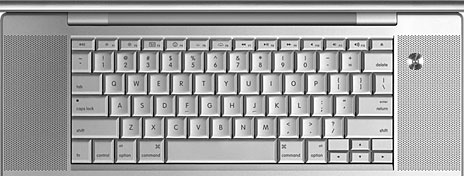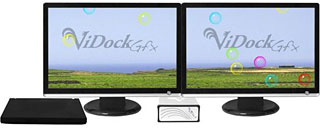I use my main workhorse notebook mostly as a desktop substitute,
which leads me to muse frequently about "desktop laptops" that would be
designed specifically for the growing constituency of laptop owners who
mainly use their 'Books as portable desktop computers and rarely for
real road work.
For that sort of user, weight and bulk are much less substantial
considerations - more of both would be tolerable in exchange for more
features, connectivity, and expandability, as well as perhaps the
integration of less expensive desktop components like hard drives and
RAM that would help keep costs down. There are some big PC laptops with
up to 19" displays and even one or two (more to come soon, it seems)
with quad-core processors.
So far Apple has chosen not to go this route, although in some
respects the 17" MacBook Pro and PowerBook are more portable desktops
than serious road warrioring machines. Yet because of their still
razor-thin profile, the full potential of the expansive footprint can
be exploited to a greater degree than it has been. For example, there
is plenty of room for a full 105-key extended keyboard, but instead the
Big 'Book uses the same keyboard as their 15" (and erstwhile 12")
siblings, leaving huge expanses of empty space on either side.

I'm not holding my breath in anticipation, but I think there could
be a healthy market for "desktop MacBooks". If Apple builds them,
perhaps with the new quad-core 2.53 GHz Centrino 2 mobile CPUs that are
reportedly coming from Intel as early as August, people would come.
Notebook Drawbacks
In the meantime, while portables have many virtues as one's only
computer, decent ergonomics for long sessions at the keyboard is not
one of them. To wit: if the 'Book is positioned low enough for a
comfortable and wrist-healthy typing posture, one's neck is craned
downward at an uncomfortable and unhealthy angle, and in many cases
shoulders will be rounded and the chest hollowed.
On the other hand, if the computer is perched at a comfortable and
good posture-inducing viewing angle, one's wrists will be angled down,
compressing the vulnerable carpal tunnel, and the arms elevated
uncomfortably.
Keyboard
The solution to these essential ergonomic issues of laptop use for
more than brief stints is to elevate the computer and use an external
keyboard and pointing device. This practice has other advantages
besides sparing your wrist and neck from possible injury. The thing I
miss most about using the built-in keyboard in Apple's 'Books is the
lack of Home, End, Page Up, Page Down, and Forward Delete keys (without
using modifiers), as well as the missing three F-keys, and I've never
found the embedded Fn key solution an adequate substitute for a real
numeric keypad with its big, convenient Enter key.
There is a wide selection of external keyboards available that one
can use, including the thin aluminum ones from Apple. My personal fave
is the
Kensington SlimType, but there are probably dozens of keyboard
choices that will variously appeal to different tastes in feel and
response, wired or wireless, and so forth. The point is that you can
get the keyboard experience that you like by going external.
Mouse
The same dynamic applies, only more so, with pointing devices, where
the range of potential candidates is truly vast - mice, both
conventional and ergonomic, and trackballs and trackpads, in a
mind-blowing variety of configurations, again both wired and wireless.
I'm an aficionado of lightweight, wired mice, and the one I use most is
the inexpensive MacMice DangerMouse
(now available from Mac-Pro), but
again let your own preferences be your guide. Apple, MacAlly, Logitech,
Kensington, RadTech, and Contour Design, to name just a few, make a
wide array of pointing device designs and configurations, and there are
plenty of other contenders, not to mention various trackballs and the
odd freestanding trackpad.
One issue with using an external mice with laptops has sometimes
been cord length, or lack of it, notably on Apple's own corded USB mice
and machines with USB ports located only on the left side, where a
short mouse cord can be problematical for right-handers. It used to be
than most USB keyboards had repeater ports, but lately, especially with
ultra-slim 'boards, those are becoming a rarity.
Screen Height
As for elevation, you could just perch the computer on a pile of
books or catalogs, but that's an inelegant solution, and with the many
and varied laptop stands available, why would you want to? Most laptop
stands also allow the computer to cool more efficiently, which should
make it last longer, and will at least minimize the intrusion of fan
noise from the cooling fan cutting in.
Again, there are so many different laptop stand solutions available
that it's best to shop around, read some reviews, and see what appeals
and suits you needs best. Some stands have active forced-air cooling fans that are larger and
slower-turning than internal ones used in laptops, which is something
to consider, especially if you're noise-averse. Others have built-in
USB hubs, which is also handy. A priority is for the stand, whatever
its accessory configuration, to raise the laptop's screen to a
comfortable viewing elevation.
If you tend to keep a lot of stuff connected to your 'Book at its
desktop workstation, but frequently also use the machine as a portable
as well, a convenient accessory is a BookEndz docking
station, which allows you to leave all of your cables connected
while just unplugging the BookEndz unit itself from the computer's port
panel. BookEndz models are available for MacBooks, MacBook Pros,
Aluminum PowerBooks (all three sizes), and for Titanium PowerBooks as
well.
External Displays
An alternative to or enhancement to using the laptop's own built-in
display while in desktop mode is to hook up an external monitor. If you
have a 'Book that supports monitor spanning (a.k.a. extended desktop),
you can to use the internal display and the external monitor in tandem,
mousing smoothly from one to the other.
iBooks only support video mirroring - the internal display is
duplicated by the external unit. There are third-party
hacks available that will induce the iBook to support monitor
spending, but there have been reports that this can cause damage to the
machine. Another issue to consider is that it has been suggested that
the stress (i.e.: heat generation) associated with driving an external
monitor for long periods of time may be contributory to logic board
video circuitry failure, especially in iBooks.
'Books with VGA Ports
The types of external display supported by Apple portables can be a
bit confusing. All machines beginning with the the G3 series PowerBooks through
the November 2001 Titanium PowerBooks (400, 500, 550, & first
generation 667 MHz) support standard VGA displays (the first generation
PowerBook 12" and iBooks with their included adapter).
'Books with DVI Ports
Beginning with the May
2002 release of the PowerBook G4, DVI output is standard with VGA
supported through an included DVI-to-VGA adapter. This configuration
includes the later TiBooks, all 17" PowerBooks, and all 15" aluminum
PowerBooks. The second
generation 12" PowerBook and later also support DVI output (with an
included DVI-to-VGA adapter). MacBook Pros have a DVI-out port for a
external display (VGA-out adapter included, composite/S-video out
adapter sold separately); The MacBooks have a Mini-DVI out port
(adapters for DVI, VGA, and composite/S-video sold separately), while
the MacBook Air requires an optional Micro-DVI adapter.
DVI for Older 'Books
If you have an older PowerBook without DVI support, want to use
a higher resolution screen, or work with up one or two external
displays, there is a way. Village Tronic's VTBook PC Card
video card supports both G3 Series and G4 PowerBooks equipped with a
Type II PC Card slot and running Mac OS 9 or Mac OS X. It
works with a VGA, DVI, or ADC monitor (with a DVI-to-ADC adapter). VT
Voilá, a Mac OS X software utility, eases multi-display use.
Unfortunately , it won't work with iBooks because they have no PC Card
slot.
Use 2 External Displays with the MacBook Pro
 If you have a MacBook Pro with an ExpressCard slot, Village
Tronic's ViDock Gfx enables
up to two additional displays to connect to your portable computer
offering uncompromised desktop class speed and quality video. With the
options of VGA, DVI Dual Link, or Dual DVI video output (Pro Edition),
all the displays currently on the market can be supported, including
the 30" ones at 2560 x 1600. Again, no MacBook support due to the lack
of an ExpressCard slot.
If you have a MacBook Pro with an ExpressCard slot, Village
Tronic's ViDock Gfx enables
up to two additional displays to connect to your portable computer
offering uncompromised desktop class speed and quality video. With the
options of VGA, DVI Dual Link, or Dual DVI video output (Pro Edition),
all the displays currently on the market can be supported, including
the 30" ones at 2560 x 1600. Again, no MacBook support due to the lack
of an ExpressCard slot.


 If you have a MacBook Pro with an ExpressCard slot, Village
Tronic's
If you have a MacBook Pro with an ExpressCard slot, Village
Tronic's 
